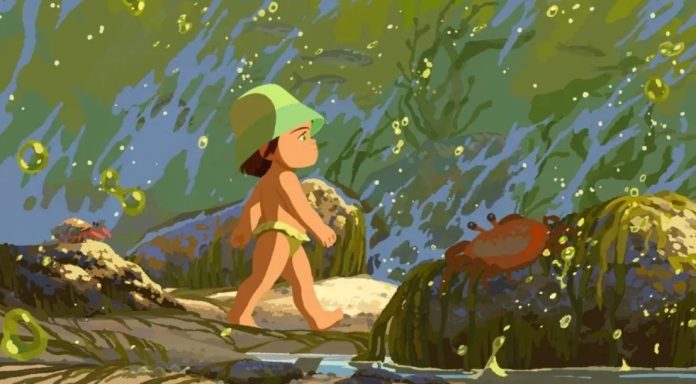THE STORY – Amélie, a Belgian child in Japan, explores life with her companion Nishio-san. Her third birthday becomes a turning point, marking the beginning of life-altering events that shape her understanding of the world.
THE CAST – Loïse Charpentier, Victoria Grobois, Yumi Fujimori, Cathy Cerda, Marc Arnaud
& Laetitia Coryn
THE TEAM – Maïlys Vallade & Liane-Cho Han (Directors/Writers), Aude Py & Eddine Noël (Writers)
THE RUNNING TIME – 78 Minutes
The coming-of-age film is an essential subgenre of cinema. With each new addition to an ever-expanding catalog, it can be seen as a filmmaker’s way of putting their most distilled form of honesty out into the world. It can feel like a massive gift to any of us who partake in such sacred ideas being shared with strangers looking at a screen. This special relationship between audience and artist is something both potent and beautiful. By observing how others perceive the world, we can gain insight into our own perception of life. We can expand so much of our own selves through engaging with art like this. And “Little Amélie or the Character of Rain,” an adaptation of the autobiographical novel by Amélie Nothomb, is such a wonderful distillation of that truth. With their beautiful film, directors Maïlys Vallade and Liane-Cho Han explore just what it means to look at the world and not fully understand everything that lies before us. But in that lack of understanding comes the opportunity for such beautiful discovery. So much of that beauty stems from one of the foundational pillars of this film: its animation style.
The film opens with narration detailing the creation of everything before focusing on our titular character. In doing so, Vallade and Han immediately showcase that, in their film, anything can occur. This may be a story based on an autobiography, but they don’t see that as a reason why fantastical elements couldn’t exist within these facts of life. The animated images we see morph at the whim of our narrator. The imagery dictates exactly what Amélie sees, or more importantly, what she perceives. And we, as the viewer, instantly see it too. These earlier moments are displayed quite literally. It’s an effective way of easing the viewer into a visual language that will expand into more metaphorical territory as the film progresses. To see the power of imaginative imagemaking in real time – which also ties into the thematic ideas of the film itself – is so exciting. That it’s all handled within minutes of the film starting is more than enough proof that audiences are in capable hands.
As “Little Amélie” introduces its titular character, an adorable three-year-old, she becomes the vessel around which this entire film revolves around. It’s yet another important stepping stone for Vallade and Han’s audience. In a film where white chocolate is so delicious that it can literally expand the mind of a toddler, it’s essential to convey Amélie’s viewpoint to the audience. And they once again nail it effortlessly. It’s one of the many humorous moments that make up this film. To see tiny children existing in a massive world as if they’re fully-grown adults is consistently funny. For everything around us that we take for granted, they look on with such an intense curiosity and eagerness to learn more. And justifiably so! Whether or not they understand it in the end is irrelevant. It’s those pure moments of curious interaction with the world around them that partially form them into the people they will become. Upon her first taste of chocolate, Amélie notes that joy brought her body to life. It’s a sentiment that should resonate with people of any age. The joys the world has to offer us are part of what makes the human experience so beautiful. But this half of life is also one half of the film. The other half lies in the people we inhabit the world alongside. In the case of Amélie, it’s her family and their housekeeper, Nishio-san.
Upon Nishio-san’s arrival, Amélie’s view of the world expands even further in ways both comical and beautiful. She likens simple household tools to those of deities, as an example. Watching Nishio-san vacuum has Amélie thinking only a god could perform such miracles as making messes disappear entirely. It’s in these funny observations, which are so incredibly specific, that the charming nature of “Little Amélie” really hits its stride. This is an adorable, beautifully animated tale of childlike wonder. As Amélie begins spending more time with Nishio-san, she starts to explore the world beyond her own mind. Yet that childish lens remains, even in the face of things she may be too young to grapple with fully. In these instances, Vallade and Han imbue the film with a sense of fantasy once again. It never lessens the emotional impact, but instead impressively heightens it. When hearing a story about yōkai, she frightfully imagines the oversized creature stalking her at the door of her own home. Upon Nishio-san describing the pain of living through wartime, Amélie experiences every noise in the kitchen as if it were sounds from Nishio-san’s own recollection of the past. These moments remind us of the simple and effective power animation has. It can imbue any sequence with layered meanings beyond the capabilities of live-action storytelling. And the film is only strengthened by the animation style it utilizes. With images that border on impressionist art, the world of “Little Amélie” feels like it’s being realized in real time. Amélie learns of the fleeting beauty of rain, her namesake, and the wild excitement that comes with flowers blooming in the springtime. These colors and shapes come together to depict the world around Amélie in a way that feels pure. It’s simple aspects like these that come together to create the complex core the film revolves around.
Across a wonderfully paced 77 minutes, “Little Amélie” grapples with a multitude of issues. As Amélie learns about death and the fleeting nature of the present, she is sent into as much of a spiral as a three-year-old can experience. It’s a frightening portion of the film as the vibrant colors we have grown accustomed to are replaced with a genuinely unnerving darkness. However, in the midst of this fear and worry, Vallade and Han allow moments of beautiful understanding to shine through, breaking the film out of its more unsettling moments. Despite a sequence or two feeling somewhat underdeveloped in this regard, the filmmakers strike a delicate balance that they handle both efficiently and meaningfully enough. It’s that balance which allows “Little Amélie” to shine. This is a film that’s as concerned with lofty ideas of existentialism as it is with the simply mundane observations of daily beauty. That both co-exist through the lens of Amélie makes this a timeless and essential tale about growing up and learning what it means to live to the fullest.


